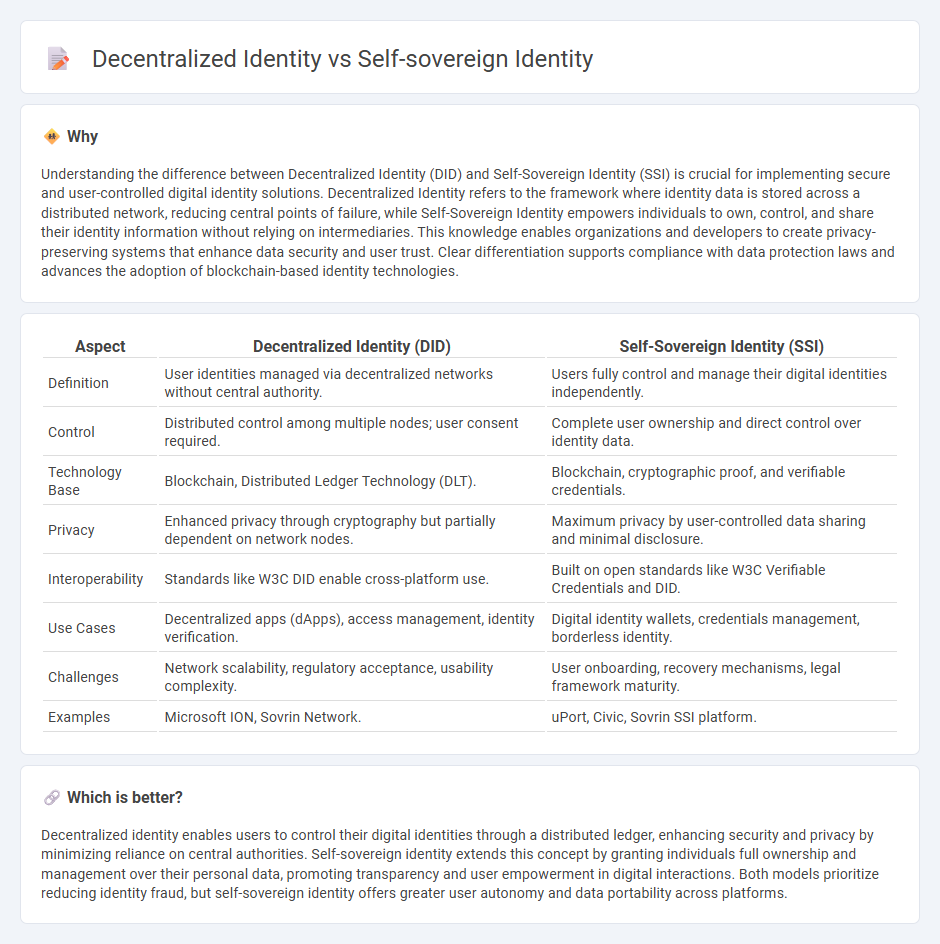
Decentralized identity leverages blockchain technology to create digital identities managed across multiple trusted nodes, enhancing security and reducing reliance on centralized authorities. Self-sovereign identity empowers individuals to fully control and manage their personal data without intermediaries, ensuring privacy and consent. Explore deeper distinctions and real-world applications to understand their impact on digital trust and identity management.
Why it is important
Understanding the difference between Decentralized Identity (DID) and Self-Sovereign Identity (SSI) is crucial for implementing secure and user-controlled digital identity solutions. Decentralized Identity refers to the framework where identity data is stored across a distributed network, reducing central points of failure, while Self-Sovereign Identity empowers individuals to own, control, and share their identity information without relying on intermediaries. This knowledge enables organizations and developers to create privacy-preserving systems that enhance data security and user trust. Clear differentiation supports compliance with data protection laws and advances the adoption of blockchain-based identity technologies.
Comparison Table
| Aspect | Decentralized Identity (DID) | Self-Sovereign Identity (SSI) |
|---|---|---|
| Definition | User identities managed via decentralized networks without central authority. | Users fully control and manage their digital identities independently. |
| Control | Distributed control among multiple nodes; user consent required. | Complete user ownership and direct control over identity data. |
| Technology Base | Blockchain, Distributed Ledger Technology (DLT). | Blockchain, cryptographic proof, and verifiable credentials. |
| Privacy | Enhanced privacy through cryptography but partially dependent on network nodes. | Maximum privacy by user-controlled data sharing and minimal disclosure. |
| Interoperability | Standards like W3C DID enable cross-platform use. | Built on open standards like W3C Verifiable Credentials and DID. |
| Use Cases | Decentralized apps (dApps), access management, identity verification. | Digital identity wallets, credentials management, borderless identity. |
| Challenges | Network scalability, regulatory acceptance, usability complexity. | User onboarding, recovery mechanisms, legal framework maturity. |
| Examples | Microsoft ION, Sovrin Network. | uPort, Civic, Sovrin SSI platform. |
Which is better?
Decentralized identity enables users to control their digital identities through a distributed ledger, enhancing security and privacy by minimizing reliance on central authorities. Self-sovereign identity extends this concept by granting individuals full ownership and management over their personal data, promoting transparency and user empowerment in digital interactions. Both models prioritize reducing identity fraud, but self-sovereign identity offers greater user autonomy and data portability across platforms.
Connection
Decentralized identity leverages blockchain technology to enable users to own and control their digital identities without relying on centralized authorities. Self-sovereign identity (SSI) embodies this concept by allowing individuals to manage and share their personal data securely and privately, enhancing transparency and reducing the risk of data breaches. Both frameworks prioritize user autonomy, cryptographic security, and interoperability across digital platforms.
Key Terms
User Control
Self-sovereign identity (SSI) emphasizes complete user control over personal data, allowing individuals to manage and share their information without intermediaries. Decentralized identity (DID) frameworks support user autonomy but often operate within ecosystems that may involve trusted authorities or consortiums, slightly limiting full sovereignty. Discover how these identity models empower users and redefine digital trust by exploring their core principles and implementations.
Blockchain
Self-sovereign identity (SSI) leverages blockchain technology to provide individuals full control over their digital identities without relying on centralized authorities, ensuring enhanced privacy and security through cryptographic proofs. Decentralized identity (DID) frameworks also use blockchain to enable verifiable credentials and interoperability across platforms, but may involve semi-centralized elements or governance models differing from pure SSI principles. Explore how blockchain innovations shape the future of digital identity management by diving deeper into SSI and DID comparisons.
Verifiable Credentials
Self-sovereign identity (SSI) empowers users to control their digital identities without intermediaries, leveraging Verifiable Credentials (VCs) as cryptographically secure proofs issued and controlled by the individual. Decentralized identity encompasses broader frameworks including SSI but involves distributed ledgers and identity hubs for trust and interoperability across different platforms. Explore the nuances of Verifiable Credentials in both SSI and decentralized identity systems to understand their impact on digital trust and privacy.
Source and External Links
Decentralized Identity, Federated Identity and Self-Sovereign Identity - This webpage discusses self-sovereign identity as a concept where individuals have full control over their digital identities and personal data, enabling them to manage their identity attributes and selectively disclose information.
Self-Sovereign Identity (SSI) - This webpage explains self-sovereign identity as a form of digital identity where users have complete control over their identity information, deciding who sees what and when, utilizing blockchain technology for security and privacy.
Self-sovereign identity - This Wikipedia page describes self-sovereign identity as an approach to digital identity that empowers individuals to control the information used to prove who they are, using decentralized systems and blockchain technology.
 dowidth.com
dowidth.com